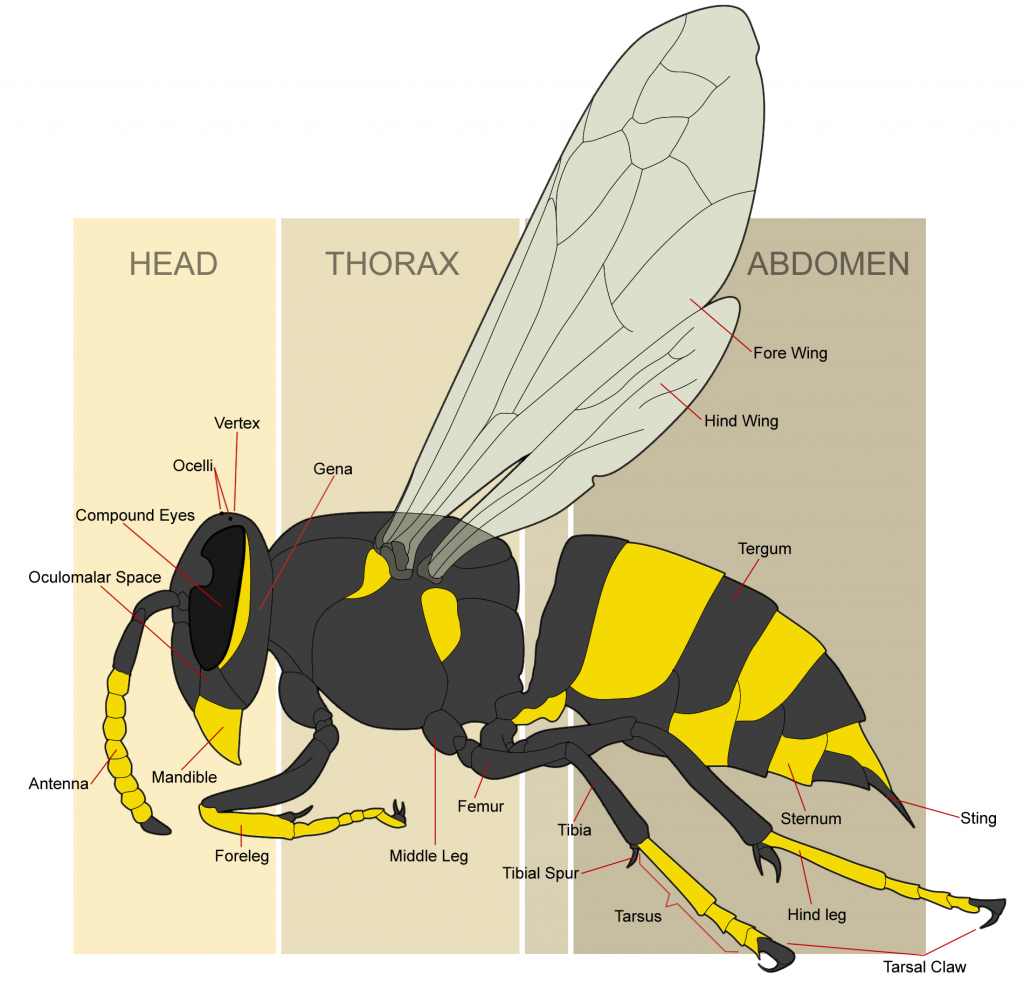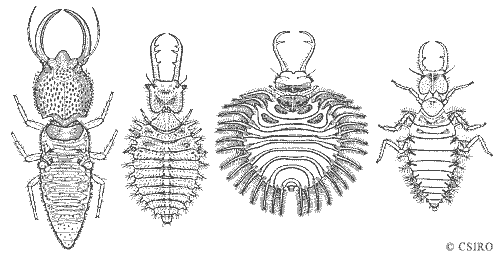Week 6: Reading
Pests, Predators, & Parasitoids: Part II
The Order Hymenoptera (meaning “Membranous Wing”) includes the ants, bees, wasps, and sawflies. More than 120,000 species have been identified, including most recently a discovery of 70 species of microwasps in Thailand. Though this group is known for charismatic macro species, these tiny wasps make up the majority of the diversity in this order.
The name Hymenoptera refers to the 2 pairs of wings that are usually clear (though they may be dark), with the forewings larger than the hindwings. Additionally, the venation in the hind wing is greatly reduced, even in the macro species (the micro species have little venation at all in both wing pairs). The anterior margin of the hind wing will also often be equipped with a row of hooks that allow the hind wing to attach to the forewing; these hooks are called “hamuli”.
Hymenoptera are holometabolous, with a maggot-like immature stage preceding the pupal stage. Both the larvae and the adults are equipped with chewing mouthparts, though there are some adaptations for lapping using a tongue-like glossae in the nectar-feeding species. The females in Hymenoptera typically have well-developed ovipositors with many species modified for stinging/venom delivery, i.e. the stingers of bees and wasps (figure 6-1).

There are two sub-orders of Hymenoptera, the Apocrita and the Symphyto. The Apocrita are identified by the separation of the basal segment of the abdomen and the thorax by a constriction, appearing as a “narrow waist” that is the petiole. Most larval Apocrita feed on other arthropods although phytophagy has reevolved several times. The abdomen of the Symphyta is joined broadly to the thorax, and nearly all are phytophagous (plant feeders).
One of the most interesting aspects of Hymeoptera biology is the evolution of a gradient of social complexities, from highly complex hives of honeybees to the solitary individuals in contact with members of their own species only for mating purposes, with many parasocial species in between these two extremes.
Many important pollinators in natural and managed landscapes belong to the Hymenoptera, and though they are not thought to be the first insects that pollinated plants (that honor goes to the Coleoptera), they are the group that celebrates the most physiological adaptation specific to providing this ecosystem service. The presence of the elongate glossae in the honeybees and bumble bees as a nectar-lapping structure is an example of this evolution, as are the structures on the legs and abdomen used for carrying either dry pollen or pollen balls mixed with nectar and saliva more easily. Behaviors utilized by colonies to communicate the location of rich food resources and physiology enhancing sensory detection of floral resources adds the the efficacy and success of the mutualism between pollinators and plants.
However, where there is fair trade, there will also always evolve means of cheating the system, and this has come about as well, on both sides of the symbiosis. Some bee species have bypassed the responsibility of pollination services by cutting into the carpel of the flower to extract the nectar. This is known as “nectar robbing”, cheating the flower of its potential to outcross and robbing the sugar-rich stores that would have fueled a true pollinator. Some plants have also found ways to take advantage of pollinator services without rewarding the assistance as well, but enticing the insects to the plant but providing no food resource in exchange.
The order Neuroptera is a diverse group of predatory insects with equipped with dense venation in the wings, seen as a network. It is this characteristic for which they are named. This group includes the lacewings, owlflies, and antlions, and used to include the Snakeflies (now order Rhaphidioptera). There are more than 5000 known species.
Members of the Neuroptera and Raphidioptera are holometabolous. They can be identified roughly by visual characteristics of the wings: the forewings are larger than the hindwings and have many veins and cross veins, appearing as a nerve network. In particular, numerous parallel humeral cross veins between the costal vein and the sub-costa should be visible. When at rest, the wings are held tent-like over the abdomen, and no terminal cerci will be present (although many females of different species have obvious ovipositors that may appear similar to cerci). All members of these orders have chewing mouthparts and are voracious predators, and many are considered beneficial in cropping systems.
Most members of these Orders are weak fliers, and are active mostly at night. Some will be attracted to lights and will gather in search of prey. Females will lay eggs in locations with available prey, many of the eggs unique. For example, the eggs of green lacewings are laid individually, each at the end of a long stalk. The larvae are predaceous at hatch, and this method prevents cannibalism (figure 6-2).


